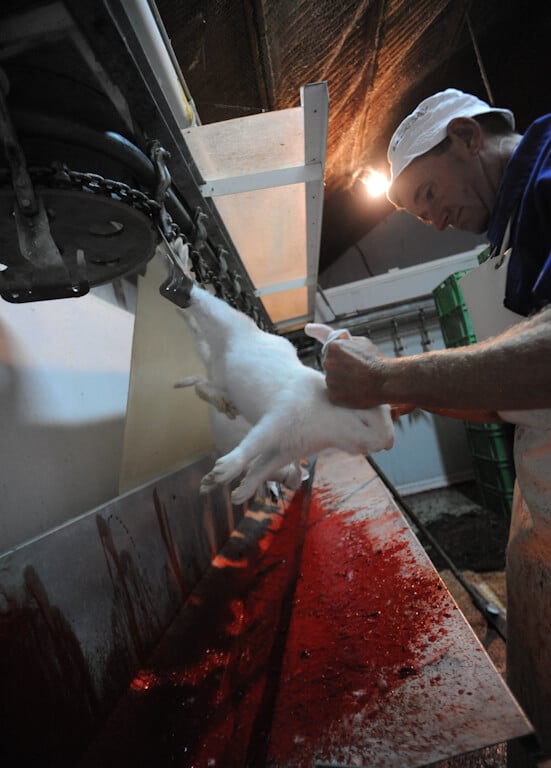Learn How Rabbits Are Exploited in Laboratories, on Angora Wool Farms, and Elsewhere This Easter Sunday
While you fill up your Easter Sunday basket with vegan chocolate bunnies, don’t forget about the bunnies who really matter. Gentle, curious rabbits suffer when humans exploit them for their fur, torment them in experiments, or abuse them in other horrific ways.
Learn more about how rabbits are suffering right now—and what you can do about it.
Used and Killed for Angora Wool and Meat
In the angora wool industry, farms typically house rabbits alone in tiny wire-mesh cages, in which they barely have room to move and are forced to live amid their own waste. These social animals often go insane from the overwhelming distress of isolation and severe confinement.
Workers often restrain gentle rabbits—who may desperately struggle to escape—and violently rip the fur from their sensitive skin. Rabbits typically endure this painful and terrifying ordeal every three months. After two to five years, those who have survived the constant abuse and miserable captivity are sent to be slaughtered.
At slaughterhouses, workers hang rabbits upside down and slit their throats so that their blood drains from their bodies. Then, their flesh is sold for meat.
Used in Experiments
More than 161,000 rabbits are abused in U.S. laboratories every year.
At the University of Pittsburgh, rabbits underwent a surgery designed to cause intentional trauma to their knee joints. After more than two weeks with their legs contorted in an unnatural, excruciating position, two of the animals had lost significant weight—indicating chronic pain and distress—but they were still forced to endure six more weeks of this agony.
Rabbits are also used in experiments to study cardiovascular disease, skin conditions, and spinal cord injuries. Experimenters at the University of Utah cut deep incisions into rabbits’ backs and surgically inserted implants into their spines. The surgically mutilated animals were observed for 24 weeks and then killed.
Exploited for Entertainment
Humans purchase rabbits as Easter gifts, use them as props in photo shoots, force them to perform in magic shows, and exploit them in other ways for entertainment.
Many families bring home bunnies as Easter gifts, without realizing the vast amount of care that these animals require. When the “bunny fever” wears off, they often discard the animals just weeks later—sometimes by “setting them free” outside and leaving them to starve or be killed by predators. Some unwanted rabbits may end up at scummy petting zoos, which subject them to a barrage of poking and prodding guests.
Sold as ‘Pets’
Rabbits are the third most common animal surrendered to animal shelters, because most people buy them on a whim, not realizing that they are high-maintenance, expensive, and long-term commitments. Caring for a rabbit involves litterbox training, bunny proofing a home, frequent grooming, trips to special veterinarians, and much more.
Every rabbit purchased from a pet store means one fewer home for another rabbit waiting for adoption at a shelter. If you’re ready for the commitment of caring for a bunny, adopt—don’t shop.
*****
If you want to do more to help rabbits throughout the year, click the button below:


